Differential Activation of Splenic cDC1 and cDC2 Cell Subsets following Poxvirus Infection of BALB/c and C57BL/6 Mice
- PMID: 38201217
- PMCID: PMC10778474
- DOI: 10.3390/cells13010013
Differential Activation of Splenic cDC1 and cDC2 Cell Subsets following Poxvirus Infection of BALB/c and C57BL/6 Mice
Abstract
Conventional dendritic cells (cDCs) are innate immune cells that play a pivotal role in inducing antiviral adaptive immune responses due to their extraordinary ability to prime and polarize naïve T cells into different effector T helper (Th) subsets. The two major subpopulations of cDCs, cDC1 (CD8α+ in mice and CD141+ in human) and cDC2 (CD11b+ in mice and CD1c+ in human), can preferentially polarize T cells toward a Th1 and Th2 phenotype, respectively. During infection with ectromelia virus (ECTV), an orthopoxvirus from the Poxviridae family, the timing and activation of an appropriate Th immune response contributes to the resistance (Th1) or susceptibility (Th2) of inbred mouse strains to the lethal form of mousepox. Due to the high plasticity and diverse properties of cDC subpopulations in regulating the quality of a specific immune response, in the present study we compared the ability of splenic cDC1 and cDC2 originating from different ECTV-infected mouse strains to mature, activate, and polarize the Th immune response during mousepox. Our results demonstrated that during early stages of mousepox, both cDC subsets from resistant C57BL/6 and susceptible BALB/c mice were activated upon in vivo ECTV infection. These cells exhibited elevated levels of surface MHC class I and II, and co-stimulatory molecules and showed enhanced potential to produce cytokines. However, both cDC subsets from BALB/c mice displayed a higher maturation status than that of their counterparts from C57BL/6 mice. Despite their higher activation status, cDC1 and cDC2 from susceptible mice produced low amounts of Th1-polarizing cytokines, including IL-12 and IFN-γ, and the ability of these cells to stimulate the proliferation and Th1 polarization of allogeneic CD4+ T cells was severely compromised. In contrast, both cDC subsets from resistant mice produced significant amounts of Th1-polarizing cytokines and demonstrated greater capability in differentiating allogeneic T cells into Th1 cells compared to cDCs from BALB/c mice. Collectively, our results indicate that in the early stages of mousepox, splenic cDC subpopulations from the resistant mouse strain can better elicit a Th1 cell-mediated response than the susceptible strain can, probably contributing to the induction of the protective immune responses necessary for the control of virus dissemination and for survival from ECTV challenge.
Keywords: Th immune response; cDC1; cDC2; dendritic cell; ectromelia virus.
Conflict of interest statement
The authors declare no conflict of interest.
Figures
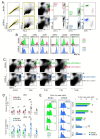

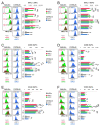
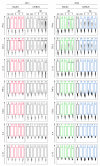


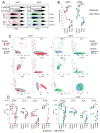
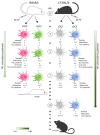
Similar articles
-
ECTV Abolishes the Ability of GM-BM Cells to Stimulate Allogeneic CD4 T Cells in a Mouse Strain-Independent Manner.Immunol Invest. 2019 May;48(4):392-409. doi: 10.1080/08820139.2019.1569676. Epub 2019 Mar 19. Immunol Invest. 2019. PMID: 30884992
-
The in Vitro Inhibitory Effect of Ectromelia Virus Infection on Innate and Adaptive Immune Properties of GM-CSF-Derived Bone Marrow Cells Is Mouse Strain-Independent.Front Microbiol. 2017 Dec 19;8:2539. doi: 10.3389/fmicb.2017.02539. eCollection 2017. Front Microbiol. 2017. PMID: 29312229 Free PMC article.
-
Deficiency in Th2 cytokine responses exacerbate orthopoxvirus infection.PLoS One. 2015 Mar 9;10(3):e0118685. doi: 10.1371/journal.pone.0118685. eCollection 2015. PLoS One. 2015. PMID: 25751266 Free PMC article.
-
Type 1 and type 2 cytokines in antiviral defense.Vet Immunol Immunopathol. 1998 May 15;63(1-2):105-9. doi: 10.1016/s0165-2427(98)00086-5. Vet Immunol Immunopathol. 1998. PMID: 9656445 Review.
-
The Pathogenesis and Immunobiology of Mousepox.Adv Immunol. 2016;129:251-76. doi: 10.1016/bs.ai.2015.10.001. Epub 2015 Nov 21. Adv Immunol. 2016. PMID: 26791861 Review.
Cited by
-
Protective effect of synbiotic combination of Lactobacillus plantarum SC-5 and olive oil extract tyrosol in a murine model of ulcerative colitis.J Transl Med. 2024 Mar 25;22(1):308. doi: 10.1186/s12967-024-05026-9. J Transl Med. 2024. PMID: 38528541 Free PMC article.
-
Cell-Cultured Influenza Vaccine Enhances IFN-γ+ T Cell and Memory T Cell Responses Following A/Victoria/2570/2019 IVR-215 (A/H1N1) Infection.Vaccines (Basel). 2024 Dec 11;12(12):1392. doi: 10.3390/vaccines12121392. Vaccines (Basel). 2024. PMID: 39772053 Free PMC article.
References
Publication types
MeSH terms
Substances
Grants and funding
LinkOut - more resources
Full Text Sources
Research Materials
Miscellaneous

